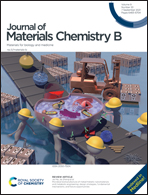Growth of mineralized collagen films by oriented calcium fluoride nanocrystal assembly with enhanced cell proliferation†
Abstract
Bone is a highly calcified tissue with 60 wt% inorganic components. It is made up of mineralized collagen fibrils, where the platelet-like hydroxyapatite nanocrystals deposit within the collagen fibrils in an oriented manner. Inspired by the special structure and biological activity of bone, we realize the intrafibrillar mineralization of collagen films with oriented calcium fluoride nanocrystals in vitro. Amorphous calcium fluoride (ACF) precursors are generated by polyacrylic acid through polymer-induced liquid precursor processes. The precursors are ready to infiltrate and fill the gap zones laterally and then diffuse to occupy the whole space inside the collagen longitudinally. Finally, the fully mineralized collagen fibrils exhibit a single-crystal-like structure after transforming precursors to co-oriented nanocrystals under the influence of arranged collagen molecules. Expanding the collagen mineralization from 1D fibrils to 2D films, the growth of mineralized areas on the films with a reaction-limited behavior is found. The kinetic rate of growth is around 0.2–0.3 μm min−1, which depends on the pH of the solution. Furthermore, the mineralized collagen films exhibit an enhanced ability of cell proliferation over the pure collagen matrices. Understanding the mineralization of artificial collagen-based scaffolds may have broad promising potentials for bone tissue regeneration and repair in the future.



 Please wait while we load your content...
Please wait while we load your content...